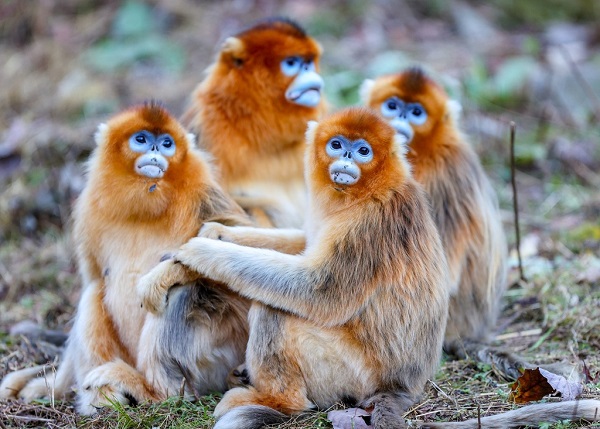Blog Post 5
Blog post 5: positional behavior and tree-gouging in Pygmy Marmoset.
At first there isn't much that I can research on when it comes to a specific detail to express in this blog spot. What originally caught my attention about this primate was its size. It’s one of the smallest primates in the world, often no larger than the palm of a human hand. They're described as squirrel-like primates in movement and appearance, with minimal sexual dimorphism between males and females. One of the more surprising aspects of their social behavior is the way raising pygmy babies, and how caring for the babies are mainly seen by the fathers. When it comes to fathers, they are primarily responsible for caregiving, while mothers focus on feeding and gather food to eat like insects and tree saps, which provide essential nutrients for their babies.
Positional Behavior:
From the article positional behavior refers to how primates move through and interact with their environment. How they climb, sit, leap, cling, or walk across various surfaces like branches, trunks, and vines. It includes both locomotion and posture. Understanding positional behavior also helps scientists connect a primate’s body structure to its ecological needs. For Pygmy Marmosets, their small size and clawed digits shape a very specific set of positional behaviors. For example, they often cling to vertical tree trunks using a posture called claw-clinging, which is rare among larger primates that usually grasp with flat nails and fingers.
Furthermore, what makes this interesting was their diet and the behaviors associated with it. Pygmy Marmosets are exudativores, which means they rely heavily on tree saps and and tree gum as a primrary source of food. A clear sign that you're in pygmy territory is the presence of tiny dental gouges in tree bark, evidence of their frequent feeding. These primates often build their lives around these trees, structuring their territories around the availability of suitable sap producing species.
In Pygmy Marmosets as explained before their morphology suggests that they hang on the sides of trees when foraging for sap and tree gum. they can support themselves through their usage of a claw like nail called tegulae which are different from the flat nails called ungula seen in other primates, including humans, and are probably an adaptation to a life spent clinging to trees (Kinzey 1997; Sussman 2000).
Tree Gouging:
Tree gouging is a specialized behavior where primates, mainly certain species of marmosets, use their sharp, lower front teeth to bite into bark and stimulate sap and tree gum flow from trees. This isn’t just casual nibbling. Pygmy Marmosets use wide jaw gapes and strong, repeated bites to score the bark, but not necessarily with extreme force. In one of the other articles it explains, the goal isn't to tear chunks out but to trigger the tree’s natural defense response so that sap begins to ooze out. Their teeth, jaw joints, and even reduced canine size are all evolutionary adaptations to make this gouging process more efficient. This method of feeding gives them access to a steady, mineral-rich resource that many other animals overlook.
Unlike many other non-human primates that rely on grasping limbs, tails, or brachiation to climb, pygmy marmosets have a unique adaptation: claw-clinging. According to Jackson (2011), about 89.6% of their feeding posture involves clinging to vertical trunks using their claw-like nails. This method isn’t just convenient, it's evolutionarily significant. The study highlights that claw-clinging and claw-climbing behaviors are tightly linked to their small body size and their feeding behavior. Claw based locomotion allows them to efficiently scale large vertical trunks to access sources, which are typically found high above ground. During feeding and gouging, they show a clear preference for large, vertical substrates, especially tree trunks.
This climbing method is also supported by their morphological evolution. The chapter The Evolutionary Morphology of Tree Gouging in Marmosets, emphasizes that marmosets like pygmy marmosets don’t need exceptionally strong bite forces to gouge trees. Like previously stated they instead rely on jaw morphology that allows for wide gapes and effective bark scoring. Contrary to earlier assumptions, gouging is more about technique than brute strength. They essentially "score" the bark to trigger sap flow rather than rip or bite it forcefully. This behavior of gouging trees with their anterior teeth is so central to their lives that it may account for up to 70% of their daily activity in some populations.
conclusion
Taken together, these traits, claw-clinging, specialized jaw function, and dietary reliance helps explain the way a primate that has evolved a unique ecological niche. Small, but behaviorally and morphologically specialized, the Pygmy Marmoset is a perfect example of how evolutionary pressures can shape everything from movement to feeding behavior. These small primates are cute and can tell a lot about how they evolutionarily changed through their behaviors in size and relationship that is between the way they feed and rely of tree sap and gum.
____________________________________________________________________
citations
“Eastern Pygmy Marmoset, Cebuella Niveiventris - New England Primate Conservancy.” New England Primate Conservancy - Committed to Leaving a Legacy of Hope and Tools to Build a Better Tomorrow for All the Earth’s Citizens, 30 May 2024, neprimateconservancy.org/eastern-pygmy-marmoset/. Accessed 02 May 2025.
Jackson, Colin Phillip. "The positional behavior of pygmy marmosets (Cebuella pygmaea) in northwestern Bolivia." Primates 52 (2011): 171-178.
“Pygmy Marmoset.” San Diego Zoo Wildlife Alliance Animals and Plants, animals.sandiegozoo.org/animals/pygmy-marmoset. Accessed 02 May 2025.
“Pygmy Marmoset.” Wisconsin National Primate Research Center, primate.wisc.edu/primate-info-net/pin-factsheets/pin-factsheet-pygmy-marmoset/. Accessed 02 May 2025.
Vinyard, Christopher J., et al. "The evolutionary morphology of tree gouging in marmosets." The smallest anthropoids: The marmoset/Callimico radiation (2009): 395-409.






Comments
Post a Comment